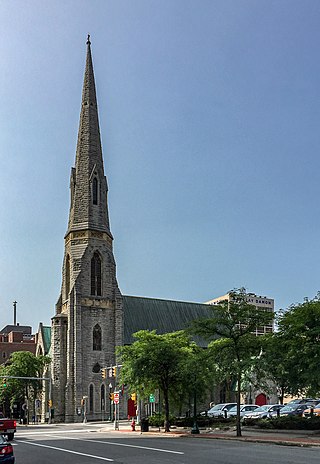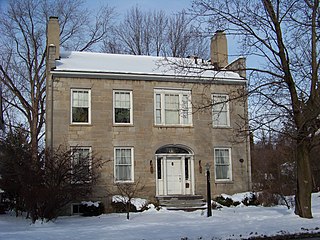Related Research Articles

Marcellus is a village in the town of Marcellus in Onondaga County, New York, United States. As of the 2020 census, the population was 1,745. The village is southwest of Syracuse and is in the southern part of the town of Marcellus.

Arthur Delevan Gilman was an American architect, designer of many Boston neighborhoods, and member of the American Institute of Architects.

Carpenter Gothic, also sometimes called Carpenter's Gothic or Rural Gothic, is a North American architectural style-designation for an application of Gothic Revival architectural detailing and picturesque massing applied to wooden structures built by house-carpenters. The abundance of North American timber and the carpenter-built vernacular architectures based upon it made a picturesque improvisation upon Gothic a natural evolution. Carpenter Gothic improvises upon features that were carved in stone in authentic Gothic architecture, whether original or in more scholarly revival styles; however, in the absence of the restraining influence of genuine Gothic structures, the style was freed to improvise and emphasize charm and quaintness rather than fidelity to received models. The genre received its impetus from the publication by Alexander Jackson Davis of Rural Residences and from detailed plans and elevations in publications by Andrew Jackson Downing.
Plainville is a hamlet on NY Route 370, approximately 4.5 miles west of Baldwinsville in Onondaga County, New York, United States.

The Gridley Building, built in 1867 and known previously as the Onondaga County Savings Bank Building, is a prominent historic building on Clinton Square and Hanover Square in Syracuse, New York, United States. It was designed by Horatio Nelson White and was built adjacent to what was then the Erie Canal and is now Erie Boulevard.

St. Paul's Cathedral in Syracuse, New York was designed by Henry Dudley, who worked with Frank Wills until Wills' early death in 1857.

The Hall of Languages is a Syracuse University building designed by Horatio Nelson White in the Second Empire architectural style, and built in 1871–73. It was the first building constructed on the Syracuse University campus and the building originally housed the entire university.

Archimedes Russell was an American architect most active in the Syracuse, New York area.

Grace Episcopal Church is an historic Episcopal parish in Syracuse, New York. The Gothic Revival building was designed by Horatio Nelson White and was built in 1876. It is located at 819 Madison Avenue near Syracuse University. On March 20, 1973, it was listed on the National Register of Historic Places.

Horatio Nelson White was an American architect based out of Syracuse, New York, and became one of New York State's most prominent architects from about 1865 to 1880. White designed many homes, armories, churches, and public buildings throughout Syracuse in Central New York, including the Hall of Languages at Syracuse University, the Oswego County Court House, Syracuse High School, the Weiting Block in Syracuse, Oswego's City Hall, and more.

The Hamilton White House is a historic home in Syracuse, New York. The house, Greek Revival in design, was built by and for Hamilton White, circa 1840/42, and occupied by his family in 1842/43. Many believe based on similarities in structure and style that the unknown architect and builder was the same person who designed and built the Moses Burnett House, completed in early 1842, later to become the Syracuse Century Club building. The house was added to the National Register of Historic Places in 1973 due to its significance in the area of architecture and its relationship, through Hamilton White, to the commerce and politics of Syracuse.
The National Register of Historic Places listings in Syracuse, New York are described below. There are 120 listed properties and districts in the city of Syracuse, including 19 business or public buildings, 13 historic districts, 6 churches, four school or university buildings, three parks, six apartment buildings, and 43 houses. Twenty-nine of the listed houses were designed by architect Ward Wellington Ward; 25 of these were listed as a group in 1996.

The John Gridley House is located in the southern section of Syracuse, New York. This section of Syracuse was originally known as Onondaga Hollow, and was settled thirty years before the City of Syracuse. The John Gridley House is significant as one of few houses remaining of the original Onondaga Hollow settlement. The two storey Federal style house was built around 1812 of local limestone. It was added to the National Register of Historic Places in 1977.

The Manlius Village Historic District is a 15-acre (6.1 ha) historic district on the east side of the Village of Manlius, in the Town of Manlius, New York, about 9.5 miles from the downtown of Syracuse.

Robert W. Gibson, AIA, was an English-born American ecclesiastical architect active in late-nineteenth- and early-twentieth-century New York state. He designed several large Manhattan churches and a number of prominent residences and institutional buildings.
Howard Hoppin was an American architect from Providence, Rhode Island.
Trinity Episcopal Church, now known as the Faith by Love Church, is a historic Episcopal church located in the Southwest / Near Westside neighborhood of Syracuse, Onondaga County, New York. The church was built in 1914–1915, and is a one-story, Collegiate Gothic style stone building. It has a steeply pitched front gable slate roof and a massive square tower with corner buttresses. Also on the property is the contributing Parish House. It is a two-story, Second Empire style frame dwelling with a mansard roof. The Jaynes Memorial Hall was added to the rear of the Parish House in 1926. The congregation was established in 1855, and remained at the location until 1994.

The third Onondaga County courthouse stood in Clinton Square, Syracuse, New York, from 1858 to 1968. Designed by Horatio Nelson White in the Italianate architectural style, the building functioned as a courthouse until 1907. After another courthouse superseded it, the building held various governmental offices for about fifty years.

The Church of St. John the Evangelist was a church in the Roman Catholic Diocese of Syracuse on 215 North State Street from 1855 to its closure in June 2010. Since 2014 the church building has housed the Samaritan Center, Syracuse's largest soup kitchen.
References
- 1 2 3 "Syracuse Becomes Focus of State Effort to Retain Its Landmarks". The New York Times. 1964-03-14. ISSN 0362-4331 . Retrieved 2022-02-13.
- 1 2 Smith, Myron Bement (1965). "Review of Architecture Worth Saving in Onondaga County". New York History. 46 (1): 97–99. ISSN 0146-437X. JSTOR 23162477.
- ↑ "Architecture Worth Saving in Onondaga County". Syracuse Then and Now. Archived from the original on December 3, 2005. Retrieved February 13, 2022.
- ↑ "UGLY CITIES AND HOW THEY GROW". The New York Times. 1964-03-15. ISSN 0362-4331 . Retrieved 2022-03-07.
- ↑ Lewis, Peirce F. (1975). "The Future of the Past: Our Clouded Vision of Historic Preservation". Pioneer America. 7 (2): 1–20. ISSN 0032-0005. JSTOR 29763553.
- ↑ Clark, Clifford E. (1976). "Domestic Architecture as an Index to Social History: The Romantic Revival and the Cult of Domesticity in America, 1840-1870". The Journal of Interdisciplinary History. 7 (1): 33–56. doi:10.2307/202373. ISSN 0022-1953. JSTOR 202373.